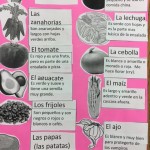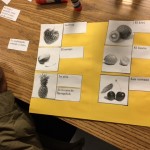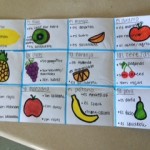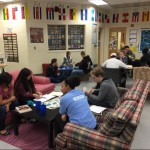So, here’s the thing that was happening in my classroom, and it has been making me crazy. I am fighting every day to be the most engaging and interesting thing in the room so that my students will pay attention to me and learn Spanish. I am speaking in the target language 90+% of the time with my big, colorful, amazing visuals, pantomiming things they don’t understand, using simplified language, and doing what I believe I am supposed to be doing. Did you roll your eyes yet? I know. I would have too.
Are you hearing your admin (or saying to yourself) “You are not supposed to be the center of attention. You are supposed to be facilitating the learning….” I get that. I hear it, but I’ve been fighting it. I felt that I needed to always be the one dancing in front. I mean, my visuals are clear and it’s not a list, right? I mean, this slide pulls prior knowledge of colors and stores and adds new vocab that I label and we describe… It’s not that bad, right? Do I sound desperate? Yeah, I felt desperate.
My principal’s favorite phrase is, “The students should be doing the heavy lifting” but I hadn’t really bought into that until recently when I realized why I was getting so irritated. I was annoyed that they’re not engaging with my amazing visuals or target language notes. Why not? Because they aren’t actually DOING anything while they’re “taking notes”. Well, that’s not true. They’re writing down what I write, drawing what I draw, and some awesome eager language-learners are actually responding to my questions. Those learners are probably 4 out of the 32 kids in my room. The rest are mostly cooperating, but even on my best day, there are students completely zoned out. Now, before you sign off this blog saying “Wow, she’s a terrible teacher”, let me share what I’ve done recently to adjust.
Let’s talk before and after…
I realized I needed a different approach to this whole note-giving thing. One that would put the responsibility on them, but still seem like something fun. So, I decided to get out of the way. I rearranged my furniture so the classroom doesn’t have a “front” anymore and changed the traditional notes from a “listen to me” format to a “read and think” format. My graphic organizer became a reading puzzle. It doesn’t have the listening component, but seriously…were they really listening?
BEFORE
Students come in, get materials, sit down, do their warmup, and then I dance around with visuals and introduce vocabulary out loud, and they write words and sentences, and maybe draw. It’s all in Spanish. It’s all solid. It’s just not particularly engaging and requires NO brain effort on their part. Basically none.
AFTER
Students still come in, get materials, sit down, do their warmup, and then they are given a notes puzzle. The “I Can” Statement is on the board as their learning target to explain WHY they have to do the notes. The “I Can” says “I Can understand a fruit or vegetable when I read a description of it” or something like that. Their eventual goal is to be able to shop for items or order food in a restaurant, but before that, they need to be able to read about food. They cut apart their puzzle, with an image, the word in Spanish, and my created description. They can’t use their phones or a dictionary, they just have to cut and sort and think until they have what they think is right. Then they ask me for help. I remove the ones that are wrong and they try again to figure it out. It takes longer than the notes would have taken, but I’m moving around my room, helping individual students question their thinking, and EVERYONE is working.
It’s not something you can do every day, but I don’t introduce vocabulary every day. I will introduce fruits on one day, and then work with them for a day or two, and then introduce vegetables. I am finding that this way of doing notes has grabbed the attention of more than 80% of the class, and they are working harder and working together to figure out the language. Some of my most reluctant students have even said “Ms. Rhodes, I love this!” which I NEVER would have thought I’d hear.
It’s made it more fun for them, and taken the pressure off of me as the sole owner of Spanish knowledge. I have included the fruit and vegetable puzzle notes below if you want to give it a try. I hope this helps take the pressure off of you too! Have fun!
Download My Fruit Vegetable Reading Puzzles





Great post, Rosalyn! We lead parallel lives in many ways. I just had a similar experience with Level 3 students when trying to do some improv theatre exercises. I like this approach that you have used here. I think we have to remind ourselves that the 90% Plus Target Language initiative doesn’t mean teacher and student have to spend the whole time speaking during that time. Ninety per cent can be reading and listening to various authentic texts.
My problem is that I know from my own experiences and from second language acquisition research that listening is crucial to becoming proficient in a language. You know, the whole subconcious learns at its own pace thing. So I stress to students how learning to listen is just as important as listening to learn to gain content. I’ve even done research and presentations on this concept. It seems just as I was getting what worked, along came the smart phone and it became even harder to hold my learners’ attention. Ugh!
So, to be fair, as a society it seems we really don’t emphasize listening anymore. I know that we especially don’t emphasize focused listening. Everything is a quick soundbyte or a mini video. We do see lots of multitasked listeners (the earbuds growing out of one ear.) We have become very visual. The average reader of digital content only reads 20% of information shared with them. However, if you’re like me, knowing all this just leads to the blame game and doesn’t solve the problem. I mean, really, who wants to hear “What’s the matter with kids, today?” So, we forge onward, sharing what we discover through action research and trying to implement what the past 30 years of 2nd language research tells us.
Thanks again for your candor. This is a very important issue. I think you are on to something.
Listening is crucial. No question. You have to listen, process, and respond appropriately as part of any communication. Input before output. I know in class sometimes when we’re creating a foldable (which we do that with listening to me give directions in Spanish) and they’re chatting instead of listening, I find myself having to remind them “This IS the listening practice. Everything I say IS the listening practice. You don’t have to wait for “an activity” to do listening practice…just focus and listen and you’ll get it.” It’s nice to know that it’s not just me trying to figure my way around these daily classroom issues. Thanks for the comment!
My beliefs about language acquisition/learning and learner role in it have recently morphed into a “chicken vs egg” dilemma that involves precisely reading and listening. French is not quite as easy to decode by novices in its print form and few students can correctly put new words into sounds. I find that when I introduce words/expressions through CI in their auditory form first (listening without any print associated), my students who were involved listeners have a better chance to have a good pronunciation. When they first see new expressions in print and thus must come up with auditory form by themselves, they are not as accurate. I have begun including specific bite-size pop-up type instruction to address phonetic patterns so my students can be sufficient decoders by the time they reach intermediate level of proficiency. To me, it really became “learn to read” at novice level in order to be able to “read to learn” beyond that. I would love to hear what others have to say on this matter.
I agree that it’s a “chicken vs egg” situation, because words that they know from hearing and speaking often mess them up when they see them in print. I’m finding that they’re not necessarily able to produce the language out loud from these puzzles, but they do have enough to cling to (because I write them) that they are able to make the connections and glean meaning. I don’t believe there is any one technique that does everything we want to teach them language. We use every trick we can come up with get traction with our students, and run with what works in that moment. It sounds like you have a good process going in your classroom. Thanks for the comment!
Thanks for this post-I’m going to use this. I find that when more responsibility is placed on my students, the better they do and the more invested they are. (My elementary kids would love an activity like this!)
I’m so glad! I find that the majority of what I do now in the classroom is based on my formative teaching years in K-6. So many techniques used in early lang are what we should still be doing in high school. Let me know how it goes!
Rosalyn, thank you so much for sharing this activity. Not only does it require the students to do the “heavy lifting”, it also frees the teacher to identify and help the ones who are struggling. Nice work!